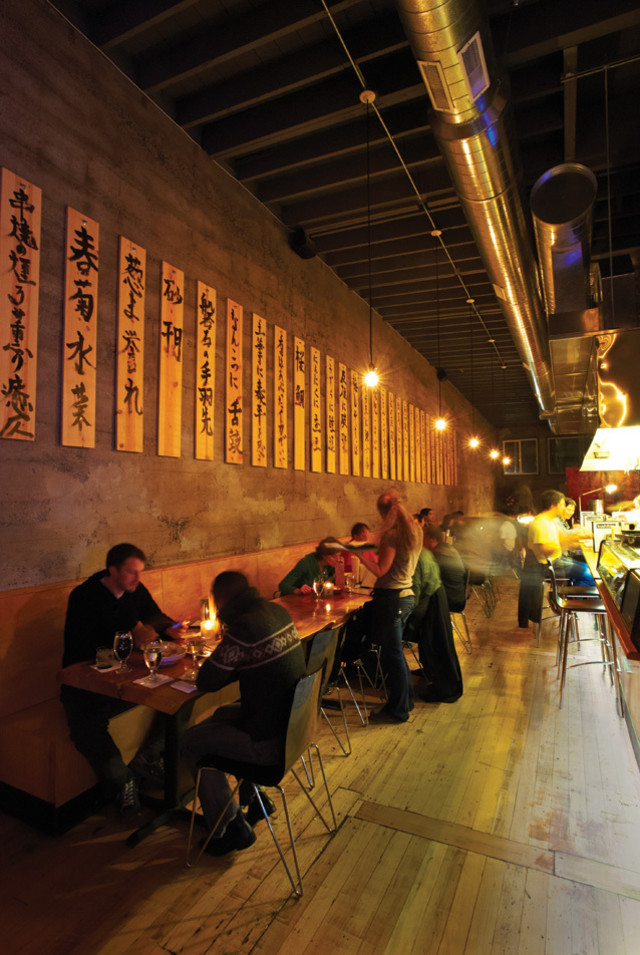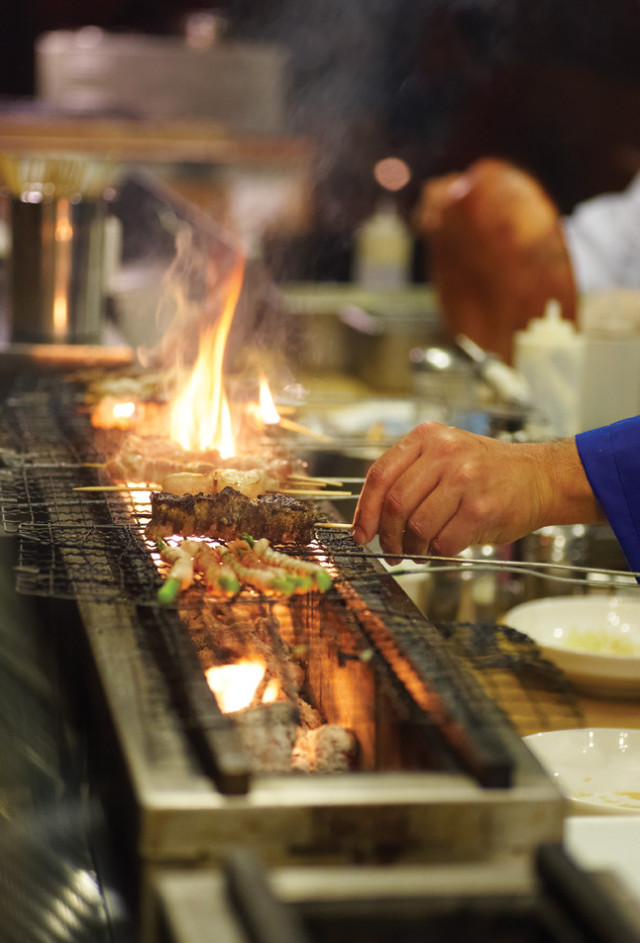Tokyo R Us

Image: Amos Morgan
What is this, Tokyo? This city’s gone crazy with ramen houses and izakaya bars, of the sort Japanese working stiffs flock to for beers and fried snacks after the five o’clock whistle. Seattle’s had upscale sushi bars for decades, but now sake shops and cream-puff stalls and mod noodle joints pulse with youthful street prowlers, and at least one dive purveys the daffy East-West hybrid cuisine called yoshoku (think Japanese spaghetti). These days, the more down-market the Japanese food, the more down this town seems to be with it.
Kushibar is one of this new breed, but a passerby would never suspect it from the street. The sign out front spells “kushibar” in coolly blue lowercase letters but means: “You are in Belltown, land of young food faddists and cocktail swillers.” Inside, I checked off the essential indicators: architectural flower arrangement at the door, dentally fortunate hostess, blue-lit bar, barely-lit restaurant, sandblasted-cement walls.
At the wider spot in the back, alongside wallpaper of life-size trees (an ironic reference to that Asian restaurant cliché?) we sat down and opened our menus. All of them. The one encased in plastic listed the specials, oden and noodle bowls, and cocktails and happy-hour noshes. The “Special List,” just a half-sheet of paper, gave no explanation of how its sweet potato tempura and shrimp shumai and so forth merited distinction from the other specials. The kushiyaki menu, listing the grilled and skewered meats and vegetables Kushibar counts as its specialty, was stapled to a thick wooden block and displayed beside containers of paper napkins and pull-apart chopsticks.
You can’t swing a sake bottle around here without hitting an Okonomiyaki, the stuffed grilled pancake that you get all over the streets of Tokyo.
Before I could puzzle out whether I was going to shove the whole wooden block into my purse or simply claw the paper off—I steal menus; occupational necessity—our “chicken set” of kushiyaki arrived. Apparently the heavier the menu, the lighter the food. These slim little skewers, charred up on sidewalk street grills across Japan, radiated prettily from the corner of a white plate. “Dark meat chicken,” our waiter narrated, as I popped a fine sweet nugget of the moist meat into my mouth. “Chicken wing,” she said needlessly. “Skin!” she declared. “Gizzards and livers! Hearts!” (Kushibar is not for the gut shy.)
The gizzards offered the gristly texture of digestive organ walls—which is what they are, after all, but not always so noticeably. The rest of the skewers—white meat, chicken hearts, rich red chicken livers—had languished far too long on the grill. The poor overworked skewer of dripping skin could only lend so much moisture. I could see the chefs from my table, painstakingly placing skewers of meat across the narrow grill, its wells glowing with embers. The chefs certainly looked vigilant. But throughout my visits the dryness problem arose again and again, from the three potent but desiccated pieces of saba (mackerel) to the skewer of tough, gently citrusy scallops.
{page break}

Skewered Kushiyaki are a staple of Japan’s sidewalk street grills.
Image: Amos Morgan
We sipped our mellow lychee cocktails and munched our gratis curry popcorn and pondered a midcourse correction. Apparently this kushiyaki bar did not excel at kushiyaki. Bummer, since so much of the place’s identity springs from the idea of street food—down to its windowy “indoor sidewalk” dining area, great in warm weather, that stretches along Second Avenue and presents Kushibar’s most authentically casual face.
Yet even a Tokyo virgin could see that kushiyaki wasn’t the only street food on Kushibar’s multifarious menus. The “street style” gyoza—skinny hand-wrapped nuggets filled with savory pork—looked like spent New Year’s poppers and featured greaseless translucent skins, sticky and charred. We gobbled them like bonbons. The “street style” pork fried rice is a version of the unscripted combo of fish guts and pig skin and other unmentionables that generations of Japanese workingmen have thrown together and called dinner. Kushibar’s is leagues tamer—though oily pork might be an unmentionable in the stylish latitudes of Belltown—but comprised of the same kitchen-sink feel, and addictively edible.
Our big bowl of tonkatsu ramen was the fullest flavored I’ve tried in this city—heads up, Boom Noodle—with its chicken and slices of succulent pork and toothsome noodles and sweet corn and scallion rings and sesame seeds and pale moons of halved egg, two fins of deep green nori blowing an ocean breeze across the bowl. For those who request it, co-owner and chef Billy Beach will float a scoop of butter on top to intensify the marrowy richness. “The Japanese use butter in cooking a lot,” he explained with a whiff of defensiveness; he’s been criticized for the Western gesture. “And it does add that sort of American touch.”
Beach himself straddles both cultures. He spent his first two decades in Okinawa, then came West and earned his chops at I Love Sushi and Wasabi Bistro, among other places. A couple years ago he cofounded Umi Sake House—part of the aforementioned izakaya invasion. To speak with the 40-year-old Beach now, you’d never know he was born in Japan. His accent has entirely vanished.
At Kushibar you can just keep ordering as your appetite demands. So my friend and I ordered okonomiyaki, the grilled pancake stuffed with pork and cabbage and drizzled with sauces that you can get all over the streets of Tokyo. A few years ago, the only place in Seattle you could get one of these was a funny little joint in Georgetown called Daimonji; now you can’t swing a sake bottle around here without hitting an okonomiyaki. Kushibar’s version is very thick and pork heavy, and overwhelmingly barbecue flavored. Its bready texture and accessibly Western flavors rank it high on the yum-o-meter. But it tasted like it had been developed during Japan Week at Arby’s.
“This is Japanese food for white people,” concluded my Japanese American companion, and he got no argument from me. Our server laid down the check, and one glance affirmed how perfectly synced up Kushibar’s food is with the zeitgeist of the day: inexpensive, homespun, comforting. Maybe that explains the ascendant popularity of street-style Japanese right now. Yes, Kushibar’s slick neon looks are misaligned with the homely cuisine. But then this is Japanese food for Belltown people.
As I got up to leave I remembered the heavy wooden kushiyaki menu—and left it right where it was.
READ MORE RESTAURANT REVIEWS.




